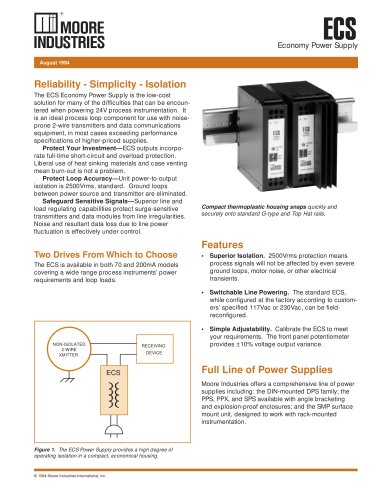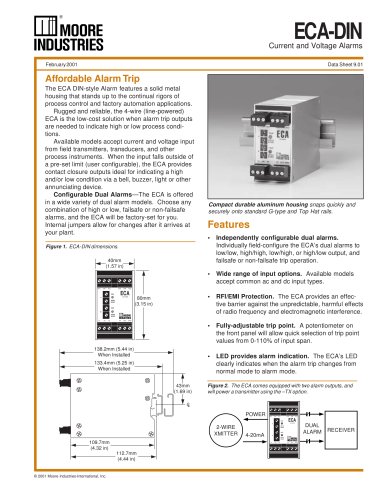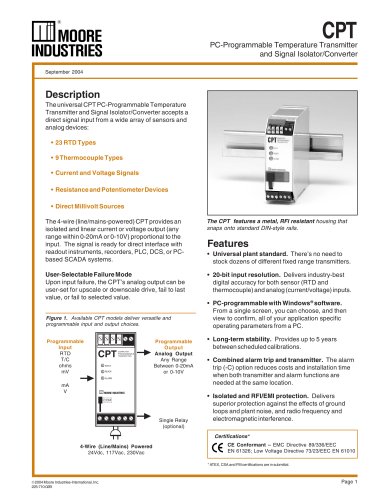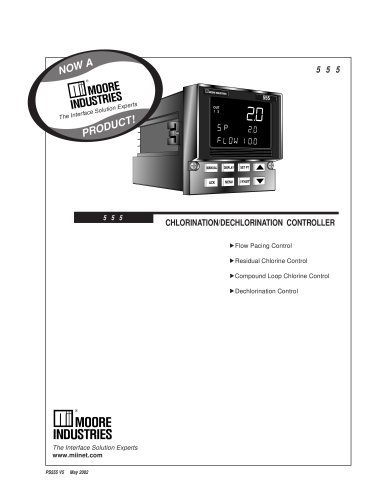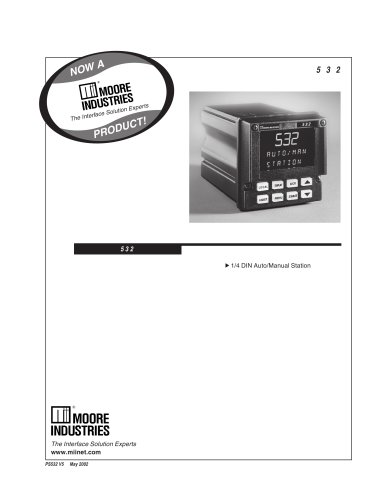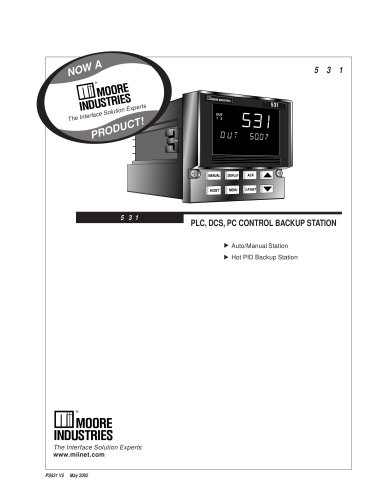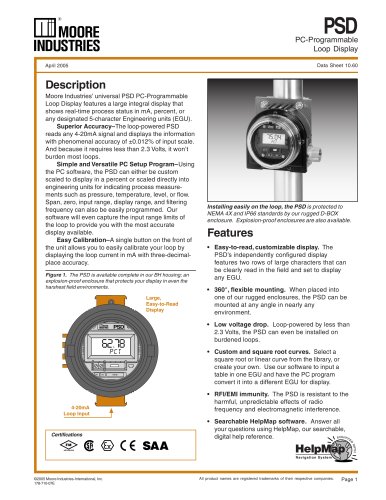
Catalog excerpts

November 2008 By using the right signal interface instruments, in the right ways, potential problems can be easily avoided well before they boil over... quite literally in some cases. Whether you call them signal isolators, signal converters or signal interfaces, these useful process instruments solve important ground loop and signal conversion chal- lenges everyday. Just as important, they are called upon to do a whole lot more. They can be used to share, split, boost, protect, step down, linearize and even digitize pro- cess signals. This guide will tell you many of the impor- tant ways signal isolators, converters and interfaces can be used, and what to look for when specifying one. > In addition to simple signal isolation and conversion, signal interface instruments can be used to share, split, boost, protect, step down, linearize and even digitize process signals. The need for signal isolation began to fl ourish in the 1960s and continues today. Electronic transmitters were quickly replacing their pneumatic predecessors because of cost, installation, maintenance and performance advantages. However, it was soon discovered that when 4-20mA (or other DC) signal wires have paths to ground at both ends of the loop, problems are likely to occur. The loop in question may be as simple as a differential pressure (DP) transmitter sending a 4-20mA measure- ment to a receiver, such as a recorder. But when the voltages (V) at the two ground points are different, a circulating, closed current (I) path is formed by the copper wires used for the 4-20mA signal and the ground (Figure 1). When this happens, an additional and unpredictable amount of current is introduced into the loop, which distorts the true measurement. This current path, known as a ground loop, is a very common source of signal inaccuracies.A ground loop forms when three conditions are present: To remove the ground loop, any one of these three conditions must be eliminated. The challenge is, the fi rst and second conditions are not plausible candidates for elimination. Why? Because you cannot always control the number of grounds, and it is often impossible to just liftӔ a ground. The ground may be required for the safe operation of an electronic device. Its also possible that the ground exists because the instrument is in physical contact with the process which, in turn, is in physical contact with the ground. From a practical standpoint, you cannot reach into the earth and regulate the voltage at these perma- nent ground points. > Figure 2. A signal isolator ғbreaks the galvanic path between two grounds. ISOLATOR +24V+Ԗ++֖ NON-ISOLATED TRANSMITTER4-20mA ISOLATED4-20mABREAKS THEGALVANIC PATH RECEIVER RECEIVER optoisolation +IN 1. There are two grounds; > +24V 2. The grounds are at different potentials; > V1 V2 3. There is a galvanic path between the grounds. > POWER SUPPLY Figure 1. A ground loop forms when the voltages at two ground points in a loop are at different potentials. +24V+֖ So what can be done? Use a signal isolator to breakӔ the galvanic path between the two grounds (Figure 2). When the conductive path between the differential voltages is broken, a current cannot form. So even though there are two grounds and different voltages at each ground, there is no current fl ow. The ground loop has been eliminated. > NON-ISOLATED TRANSMITTER 4-20mAV2 RECEIVER RECEIVER +IN GROUND LOOP IӔ V1 The Interface Solution Experts www.miinet.com > թ2008 Moore Industries-International, Inc. Page 1 size="-1">
Open the catalog to page 1
Transformer Isolation Transformer isolation (Figure 4), often referred to as electromagnetic isolation, uses a transformer to electromagnetically couple the de- sired signal across an air gap or non-conductive isolation gap. The electromagnetic fi eld intensity is proportional to the input signal applied to the transformer. Transformers are very effi cient and fast at transferring AC (alternating current) signals. Since many process control signals are DC, they must be electrically דchopped into an AC signal so they can pass across the transformer. Once passed, they have to be rectifi ed...
Open the catalog to page 2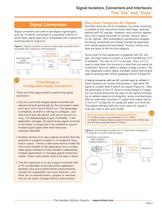
Normally when you think of isolators, you think of solving a problem at the instrument control level layer, typically dealing with DC signals. However, very common applica- tions use a signal converter to monitor, trend or alarm on AC signals. With preventative maintenance budgets shrinking, companies are closely monitoring expensive and critical equipment purchases. Pumps, motors and fans are quick to fall into this category. Since much of this equipment is powered with AC volt-age, and high levels of current, a current transformer (CT) is installed. The role of a CT is two-fold. First, a...
Open the catalog to page 3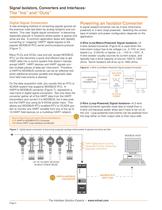
A new emerging method of converting signals ignores all the previous rules laid down by analog isolators and con- verters. This new digital signal conversionӔ is becoming especially popular in locations where power is sparse and wires are few. A common application deals with digitally converting or mappingӔ HART > A signal isolator/converter can be 4-wire (line/mains- powered) or 2-wire (loop-powered). Selecting the correct type of isolator and power confi guration depends on the application. 4-Wire (Line/Mains-Powered) Signal Isolators A4-wire isolator/converter (Figure 8) is used when the...
Open the catalog to page 4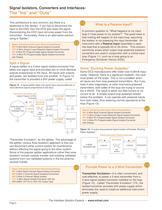
Moore Industries Instrument Recommendations:MIX 2-Wire Multi-Channel Signal Isolator/Converter ECT 2-Wire (Output Loop-Powered) Signal Isolator/Converter SIY 2-Wire PC-Programmable Signal Isolator/Converter SDY 2-Wire PC-Programmable Signal Isolator/Converter with Display > Figure 12. A signal splitter takes one signal input and provides two or more identical outputs proportional to the input. > Transmitter Excitation (TX): +A +OUT Isolator Powers a 2-Wire Transmitter ISOLATED 4-20mA RECEIVER1 24V ISOLATORSPLITTER +ז NON-ISOLATED2-WIRETRANSMITTER +TX+IN A OUT֖ 4-20mA B +OUTB OUT Moore...
Open the catalog to page 6
Figure 15. A HART isolator allows the HART digital signal to pass through the isolator. > HART DIGITAL SIGNAL HART DIGITAL SIGNAL +24V+IN+24V+IN+Ԗ + ISOLATED2-WIREHART TRANSMITTER ISOLATED 4-20mA Loop ISOLATED4-20mA Loop DCS + ֖ HARTISOLATOR Moore Industries Instrument Recommendations:MIX 2-Wire Multi-Channel Signal Isolator/Converter ECT 2-Wire (Output Loop-Powered) Signal Isolator/Converter SIY 2-Wire PC-Programmable Signal Isolator/Converter SDY 2-Wire PC-Programmable Signal Isolator/Converter with Display Moore Industries Instrument Recommendations: HIX Figure 14. A signal isolator adds...
Open the catalog to page 7All Moore Industries catalogs and technical brochures
-
SB
2 Pages
-
LH
2 Pages
-
TMZ
8 Pages
-
CPT (Current/Voltage Input)
8 Pages
-
CCS - Cable Concentrator System
12 Pages
-
HIM HART® Interface Module
8 Pages





